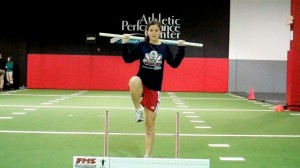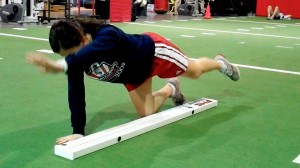Brian Schiff’s Blog
Injury Prevention, Sports Rehab & Performance Training Expert
Increasing hip strength and stability is a common focus in training and injury prevention programs. Current research indicates hip and knee strengthening is more effective than knee strengthening alone in those suffering from anterior knee pain. I routinely use mini-bands to strengthen the hips and maximize proximal stability.
Many clients struggle with poor proximal hip stability that shows up as excessive frontal plane adduction and compensatory trunk lean. This exercise targets the hips and closed chain control needed for those participating in jumping, running, cutting and pivoting activities. It is an excellent way to warm-up and activate the hips as well as reduce patellofemoral overload and prevent knee injuries.
Over the past several years, the trend in the health and fitness industry has been toward injury prevention and movement screening. Gray Cook and Lee Burton have given us the FMS. More recently, the Y-Balance test has emerged as another tool to assess asymmetry in the upper and lower quarter.
I am currently FMS certified and planning to attend the SFMA course next month in Durham. I routinely incorporate the FMS in both our rehab and sports performance work at the APC. I like many things about the screening exam. It provides a consistent tool to assess baseline movement and record asymmetry on a simple 4 point scale scale. It also has been shown to have good intra and inter-rater reliability. Click here for a recent study published in the Journal or Orthopaedic & Sports Physical Therapy.
For those unfamiliar with the screen, it is 7 tests scored on a 0-3 scale as follows:
- 0 = pain
- 1 = unable to perform the movement pattern (or perform with marked dysfunction)
- 2 = performs the movement with a mild compensation
- 3 = performs the movement correctly
I would say on average, most of the athletes I screen score between a 12 and 15. My highest score was a 19 (9 year old gymnast) and my lowest was a 9 (NFL lineman). As screeners, we are charged with uncovering asymmetry and faulty movement patterns. What do you see in the following picture?

Clearly, the dowel is not level, thus we score it a 2. She also had some ER in the right leg when stepping over the hurdle. She was a symmetrical 2 on the hurdle step test. This is a Division I soccer player who scored 17 on the exam.
Most of the movements seem straightforward. However, many question what the rotary stability test measures with respect to the ideal 3 score (ipsilateral movement)? It assesses an unnatural movement pattern to be sure. This athlete failed miserably on the ipsilateral pattern but scored a solid 2 with the contralateral pattern.

I have yet to test someone who can score a legitimate 3. I have seen some get a 3 on one side and 2 on the other (asymmetrical and a red flag in FMS land). As one who naturally questions things, I find myself questioning how many are truly capable of scoring a 3.
ACL injuries continue to proliferate among female athletes. I am passionate about preventing them, and part of my professional mission is to study and evolve in my rehab and prevention training approaches all the time to stay on top. I wanted to pass along some new information on a new screening tool just unveiled in the Strength and Conditioning Journal this month.
Before I reveal the screening and training tool, I want to take a moment and review what Timothy Hewett refers to as modifiable risk factors that contribute to injury risk based on his work:
- Ligament Dominance – defined as an imbalance b/w neuromuscular and ligamentous control of dynamic knee stability and it is visualized by loss of frontal plane control with landing and cutting
- Quadriceps Dominance – defined as an imbalance between quad and hamstring strength, recruitment and coordination
- Leg Dominance – defined as an imbalance between the two legs with respect to strength, coordination and control
- Trunk Dominance ‘Core’ Dysfunction – defined as an imbalance b/w the inertial demands on the trunk and its ability to resist or control/resist it
Previously, Hewett has identified that high knee abduction moments are related to high LOAD on the knee and a major risk factor for ACL injury. He and his colleagues have done extensive motion analysis in their lab in Cincinnati, OH. As such, a drop landing test has been used as one tool to observe landing mechanics and assign some risk value to athletes competing in cutting and jumping sports.
In the current article (click here for the abstract) Meyer, Brent, Ford and Hewett unveil a new screening tool involving the tuck jump. They propose that this tool is easier for the S & C coaches to do on the field and not only assess risk factors by way of observing technical flaws, but also use the tool as a training maneuver.
The idea is the subject will perform tuck jumps for 10 seconds consecutively while the observer makes notes on the following pre, mid and post jumping:
- Lower extremity valgus at landing
- Thighs do not reach parallel (peak height of jump)
- Thighs not equal side-to-side (during flight)
- Foot placement not shoulder width apart
- Foot placement not parallel (front to back)
- Foot contact timing not equal
- Excessive landing contact noise
- Pause b/w jumps
- Technique declines prior to 10 seconds
- Does not land in same footprint (excessive in flight motion)
Factors 1-3 refer to knee and thigh motion, 4-7 refer to foot position during landing and 8-10 refer to plyometric technique. Coaches are instructed to grade the flaws if seen with check marks during the phases they are seen and use this as a guide for correction. They may also use cameras in the frontal and sagittal plane to assist them.
My thoughts on this are:
- There is sound science behind the rationale for the test and modifiable risk factors
- There is a need for basic no-cost screening tools coaches can apply in their settings
- The tuck jump assessment will provide instant feedback on form and identify technical flaws that may indicate higher risk for injury
- The tuck jump is a higher demand plyo drill so I fear poor form may be as much to blame on inexperience and unrefined motor patterns as it is to just dominance patterns so we need to keep plyo training experience in mind when analyzing the screen results especially for beginners
- The tuck jump assessment does not really consider fundamental movement restrictions that may bias the form on one side if an asymmetry is present
- I still wonder how much ankle pronation impacts landing and whether we will see more research on this – there was a study done at ECU where they used orthotics and saw a reduction in ACL tears in their collegiate athletes so I have to wonder about this crucial element of the kinetic chain
In the end, we still lack many answers. According to data published in the Journal of Athletic Training in 2006, non targeted neuromuscular training programs need to be applied to 89 female athletes to prevent 1 ACL tear. So, we need to keep studying and applying science to our training, all the while critically questioning science and looking at our athletes holistically to find the best prevention strategies for each one individually and for at risk athletes as a whole.

